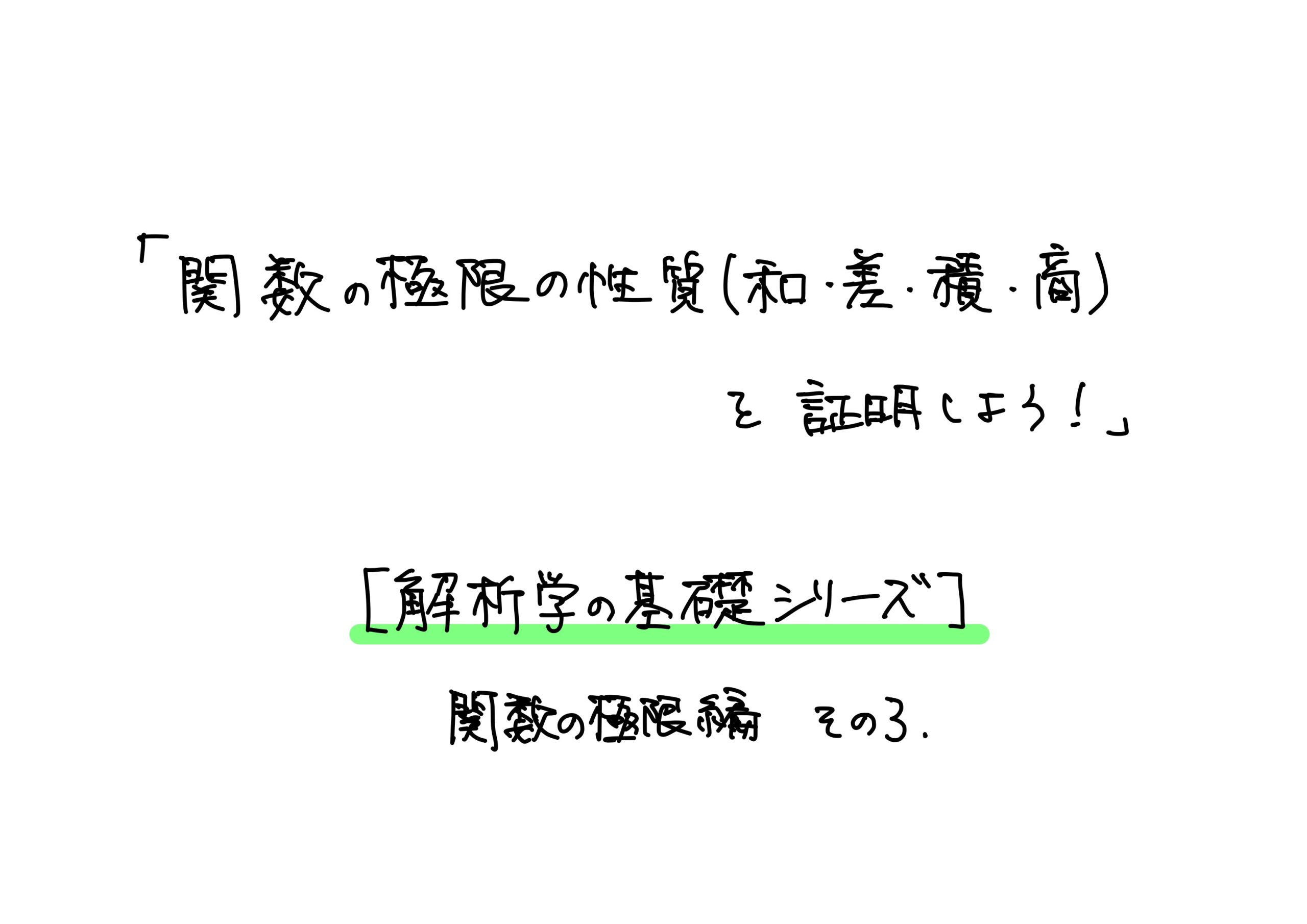- 本記事の内容
- 関数の極限の性質とその証明
- 1.\(\displaystyle \lim_{x\to a}(f(x)+g(x))=\lim_{x\to a}f(x)+\lim_{x\to a}g(x)=A+B\)の証明
- 2.\(\displaystyle \lim_{x\to a}(f(x)-g(x))=\lim_{x\to a}f(x)-\lim_{x\to a}g(x)=A-B\)の証明
- 3.\(\displaystyle \lim_{x\to a}f(x)g(x)=\left(\lim_{x\to a}f(x)\right)\cdot\left(\lim_{x\to a}g(x)\right)=AB\)の証明
- 4.\(\displaystyle \lim_{x\to a}\frac{f(x)}{g(x)}=\frac{\displaystyle\lim_{x\to a}f(x)}{\displaystyle\lim_{x\to a}g(x)}=\frac{A}{B}\)の証明
- 余談その2(筆者の勘所)
- 結
本記事の内容
本記事は関数の極限の性質、特に極限の和・差・積・商についての証明を与える記事である。
本記事を読むにあたり、関数の極限を知っているとより理解が深まると思われるので、その際は以下の記事を参照してください。
関数の極限の性質とその証明
数列のときと同様に、関数の和、差、積、商の極限にも似た性質がある。
関数の極限の証明の良い練習問題となると思うので是非挑戦してみてほしい。
ただ、初見では「思いつかねえよ!」というのもある(積、商の極限が初見殺し)。
\(I\)を\(\mathbb{R}\)の区間、\(f:I\to\mathbb{R}\)および\(g:I\to\mathbb{R}\)を関数、\(a\in\bar{I}\)、\(A,b\in\mathbb{R}\)とし、\(\displaystyle \lim_{x\to a}f(x)=A\)、\(\displaystyle \lim_{x\to a}g(x)=B\)とする。 このとき、次が成り立つ。
- \(\displaystyle \lim_{x\to a}(f(x)+g(x))=\lim_{x\to a}f(x)+\lim_{x\to a}g(x)=A+B\),
- \(\displaystyle \lim_{x\to a}(f(x)-g(x))=\lim_{x\to a}f(x)-\lim_{x\to a}g(x)=A-B\),
- \(\displaystyle \lim_{x\to a}f(x)g(x)=\left(\lim_{x\to a}f(x)\right)\cdot\left(\lim_{x\to a}g(x)\right)=AB\),
- \(B\neq0\)ならば、\(\delta_0>0\)が存在して、\(|x-a|<\delta_0\)なる\(x\in I\)に対して、\(g(x)\neq 0\)で、\(\displaystyle \lim_{x\to a}\frac{f(x)}{g(x)}=\frac{\displaystyle\lim_{x\to a}f(x)}{\displaystyle\lim_{x\to a}g(x)}=\frac{A}{B}\)
1.\(\displaystyle \lim_{x\to a}(f(x)+g(x))=\lim_{x\to a}f(x)+\lim_{x\to a}g(x)=A+B\)の証明
(1.の証明)
\(\displaystyle \lim_{x\to a}f(x)=A\)、\(\displaystyle \lim_{x\to a}g(x)=B\)とする。
このとき、示したいことは
$$(\forall \epsilon>0)(\exists \delta>0)\ {\rm s.t.}\ (\forall x\in I\ 0<|x-a|<\delta\Rightarrow |(f(x)+g(x))-(A+B)|<\epsilon)$$
である。 つまり、上記を満たすような\(\delta>0\)を見つけてくれば良い。
今、\(\displaystyle \lim_{x\to a}f(x)=A\)、\(\displaystyle \lim_{x\to a}g(x)=B\)なのだから、
- \(\displaystyle(\forall \epsilon_1>0)(\exists \delta_1>0)\ {\rm s.t.}\ (\forall x\in I\ 0<|x-a|<\delta_1\Rightarrow |f(x)-A|<\epsilon_1)\),
- \(\displaystyle(\forall \epsilon_2>0)(\exists \delta_2>0)\ {\rm s.t.}\ (\forall x\in I\ 0<|x-a|<\delta_2\Rightarrow |g(x)-B|<\epsilon_2)\)
が同時に成り立っている。
すなわち、上記を満たすような、\(\delta_1\)および\(\delta_2\)を見つけることができる。
\(\epsilon_1\)および\(\epsilon_2\)は任意の正の実数なので、\(\epsilon_1\)と\(\epsilon_2\)をまとめて、新たに\(\epsilon>\)を用いて\(\displaystyle\frac{\epsilon}{2}\)としても成り立つ。
すると、
- \(\displaystyle\left(\forall \frac{\epsilon}{2}>0\right)(\exists \delta_1>0)\ {\rm s.t.}\ \left(\forall x\in I\ 0<|x-a|<\delta_1\Rightarrow |f(x)-A|<\frac{\epsilon}{2}\right)\),
- \(\displaystyle\left(\forall \frac{\epsilon}{2}>0\right)(\exists \delta_2>0)\ {\rm s.t.}\ \left(\forall x\in I\ 0<|x-a|<\delta_2\Rightarrow |g(x)-B|<\frac{\epsilon}{2}\right)\)
が同時に成り立っている。
\(\delta\)として、先程見つけた\(\delta_1\)と\(\delta_2\)のうち小さい方を採用する(\(\delta=\min\{\delta_1,\delta_2\}\))と、任意の正の実数\(\epsilon\)に対して、\(x\in I\)が\(0<|x-a|<\delta\)ならば\(\displaystyle|f(x)-A|<\frac{\epsilon}{2}\)かつ\(\displaystyle|g(x)-B|<\frac{\epsilon}{2}\)が成り立っている。
すなわち、
$$(\forall \epsilon>0)(\exists \delta>0)\ {\rm s.t.}\ \left(\forall x\in I\ 0<|x-a|<\delta\Rightarrow |f(x)-A|<\frac{\epsilon}{2}かつ|g(x)-B|<\frac{\epsilon}{2}\right)$$
が成り立っている。
このとき、
\begin{eqnarray}
|(f(x)+g(x))-(A+B)|&=&|(f(x)-A)+(g(x)-B)| \\
&<&|f(x)-A|+|g(x)-B|\\
&<&\frac{\epsilon}{2}+\frac{\epsilon}{2}=\epsilon
\end{eqnarray}
である。
従って、
$$(\forall \epsilon>0)(\exists \delta>0)\ {\rm s.t.}\ \left(\forall x\in I\ 0<|x-a|<\delta\Rightarrow |(f(x)+g(x))-(A+B)|<\epsilon\right)$$
が成り立つので、
$$\lim_{x\to a}(f(x)+g(x))=\lim_{x\to a}f(x)+\lim_{x\to a}g(x)=A+B$$
である。
(Q.E.D.)
2.\(\displaystyle \lim_{x\to a}(f(x)-g(x))=\lim_{x\to a}f(x)-\lim_{x\to a}g(x)=A-B\)の証明
1.と殆ど同じであるので、ぜひ1.をマネして証明に挑戦してみてほしい。
(2.の証明)
\(\displaystyle \lim_{x\to a}f(x)=A\)、\(\displaystyle \lim_{x\to a}g(x)=B\)とする。
このとき、示したいことは
$$(\forall \epsilon>0)(\exists \delta>0)\ {\rm s.t.}\ (\forall x\in I\ 0<|x-a|<\delta\Rightarrow |(f(x)-g(x))-(A-B)|<\epsilon)$$
である。
つまり、上記を満たすような\(\delta>0\)を見つけてくれば良い。
今、\(\displaystyle \lim_{x\to a}f(x)=A\)、\(\displaystyle \lim_{x\to a}g(x)=B\)なのだから、
- \(\displaystyle(\forall \epsilon_1>0)(\exists \delta_1>0)\ {\rm s.t.}\ (\forall x\in I\ 0<|x-a|<\delta_1\Rightarrow |f(x)-A|<\epsilon_1)\),
- \(\displaystyle(\forall \epsilon_2>0)(\exists \delta_2>0)\ {\rm s.t.}\ (\forall x\in I\ 0<|x-a|<\delta_2\Rightarrow |g(x)-B|<\epsilon_2)\)
が同時に成り立っている。
すなわち、上記を満たすような、\(\delta_1\)および\(\delta_2\)を見つけることができる。
\(\epsilon_1\)および\(\epsilon_2\)は任意の正の実数なので、\(\epsilon_1\)と\(\epsilon_2\)をまとめて、新たに\(\epsilon>\)を用いて\(\dfrac{\epsilon}{2}\)としても成り立つ。
すると、
- \(\displaystyle\left(\forall \frac{\epsilon}{2}>0\right)(\exists \delta_1>0)\ {\rm s.t.}\ \left(\forall x\in I\ |x-a|<\delta_1\Rightarrow |f(x)-A|<\frac{\epsilon}{2}\right)\),
- \(\displaystyle\left(\forall \frac{\epsilon}{2}>0\right)(\exists \delta_2>0)\ {\rm s.t.}\ \left(\forall x\in I\ |x-a|<\delta_2\Rightarrow |g(x)-B|<\frac{\epsilon}{2}\right)\)
が同時に成り立っている。
\(\delta\)として、先程見つけた\(\delta_1\)と\(\delta_2\)のうち小さい方を採用する(\(\delta=\min\{\delta_1,\delta_2\}\))と、任意の正の実数\(\epsilon\)に対して、\(x\in I\)が\(0<|x-a|<\delta\)ならば\(|f(x)-A|<\dfrac{\epsilon}{2}\)かつ\(|g(x)-B|<\dfrac{\epsilon}{2}\)が成り立っている。
すなわち、
$$(\forall \epsilon>0)(\exists \delta>0)\ {\rm s.t.}\ \left(\forall x\in I\ |x-a|<\delta\Rightarrow |(f(x)-A|<\frac{\epsilon}{2}かつ|g(x)-B|<\frac{\epsilon}{2}\right)$$
が成り立っている。
このとき、
\begin{eqnarray}
|(f(x)-g(x))-(A-B)|&=&|(f(x)-A)+(B-g(x))| \\
&<&|f(x)-A|+|B-g(x)|\\
&<&\frac{\epsilon}{2}+\frac{\epsilon}{2}=\epsilon
\end{eqnarray} である。
従って、
$$(\forall \epsilon>0)(\exists \delta>0)\ {\rm s.t.}\ (\forall x\in I\ |x-a|<\delta\Rightarrow |(f(x)-g(x))-(A-B)|<\epsilon)$$
が成り立つので、
$$\lim_{x\to a}(f(x)-g(x))=\lim_{x\to a}f(x)-\lim_{x\to a}g(x)=A-B$$
である。
(Q.E.D.)
3.\(\displaystyle \lim_{x\to a}f(x)g(x)=\left(\lim_{x\to a}f(x)\right)\cdot\left(\lim_{x\to a}g(x)\right)=AB\)の証明
1.,2.と比べて少々テクニカルである。
(3.の証明)
\(\displaystyle \lim_{x\to a}f(x)=A\)、\(\displaystyle \lim_{x\to a}g(x)=B\)とする。
このとき、示したいことは
$$(\forall \epsilon>0)(\exists \delta>0)\ {\rm s.t.}\ (\forall x\in I\ |x-a|<\delta\Rightarrow |(f(x)g(x))-AB|<\epsilon)$$
である。
つまり、上記を満たすような\(\delta>0\)を見つけてくれば良い。
今、\(\displaystyle \lim_{x\to a}f(x)=A\)、\(\displaystyle \lim_{x\to a}g(x)=B\)なのだから、
- \(\displaystyle(\forall \epsilon_1>0)(\exists \delta_1>0)\ {\rm s.t.}\ (\forall x\in I\ 0<|x-a|<\delta_1\Rightarrow |f(x)-A|<\epsilon_1)\),
- \(\displaystyle(\forall \epsilon_2>0)(\exists \delta_2>0)\ {\rm s.t.}\ (\forall x\in I\ 0<|x-a|<\delta_2\Rightarrow |g(x)-B|<\epsilon_2)\)
が同時に成り立っている。
すなわち、上記を満たすような、\(\delta_1\)および\(\delta_2\)を見つけることができる。
ここで、
$$\displaystyle(\forall \epsilon_1>0)(\exists \delta_1>0)\ {\rm s.t.}\ (\forall x\in I\ |x-a|<\delta_1\Rightarrow |f(x)-A|<\epsilon_1)$$
が成り立っているのだから、\(\epsilon_1=1\)としても成り立つ。
故に、\(0<|x-a|<\delta_1\)なる\(x\in I\)に対して、\(|f(x)-A|<1\)が成り立っている。
\(|f(x)|-|A|\leq |f(x)-A|<1\)(\(|a|-|b|\leq|a-b|\)を使っている)なのだから、\(|f(x)|<1+|A|\)である。
すなわち、\(0<|x-a|<\delta_1\)なる\(x\in I\)については、\(f\)は有界なのである。
さて、\(\epsilon_1\)および\(\epsilon_2\)は任意の正の実数なので、\(\epsilon>0\)を用いて\(\epsilon_1=\dfrac{\epsilon}{2|B|}\)、\(\epsilon_2=\dfrac{\epsilon}{2(1+|A|)}\)としても成り立つ。
すると、
- \(\displaystyle\left(\forall \frac{\epsilon}{2|B|}>0\right)(\exists \delta_1>0)\ {\rm s.t.}\ \left(\forall x\in I\ |x-a|<\delta_1\Rightarrow |f(x)-A|<\frac{\epsilon}{2|B|}\right)\),
- \(\displaystyle\left(\forall \frac{\epsilon}{2(1+|A|)}>0\right)(\exists \delta_2>0)\ {\rm s.t.}\ \left(\forall x\in I\ |x-a|<\delta_2\Rightarrow |g(x)-B|<\frac{\epsilon}{2(1+|A|)}\right)\)
が同時に成り立っている。
\(\delta\)として、先程見つけた\(\delta_1\)と\(\delta_2\)のうち小さい方を採用する(\(\delta=\min\{\delta_1,\delta_2\}\))と、任意の正の実数\(\epsilon\)に対して、\(x\in I\)が\(0<|x-a|<\delta\)ならば\(\displaystyle|f(x)-A|<\frac{\epsilon}{2|B|}\)かつ\(\displaystyle|g(x)-B|<\frac{\epsilon}{2(1+|A|)}\)が成り立っている。
すなわち、
$$(\forall \epsilon>0)(\exists \delta>0)\ {\rm s.t.}\ \left(\forall x\in I\ |x-a|<\delta\Rightarrow |(f(x)-A|<\frac{\epsilon}{2|B|}かつ|g(x)-B|<\frac{\epsilon}{2(1+|A|)}\right)$$
が成り立っている。
このとき、
\begin{eqnarray}
|f(x)g(x)-AB|&=&|f(x)g(x)-AB+f(x)B+f(x)B|\\
&=&|f(x)(g(x)-B)+B(f(x)-A)|\\
&\leq&|f(x)|\cdot|g(x)-B|+|B|\cdot|f(x)-A|\\
&<&(1+|A|)\cdot|g(x)-B|+|B|\cdot|f(x)-A|\\
&<&(1+|A|)\cdot \frac{\epsilon}{2(1+|A|)}+|B|\cdot \frac{\epsilon}{2|B|}\\
&=&\frac{\epsilon}{2}+\frac{\epsilon}{2}=\epsilon
\end{eqnarray}
である。
従って、
$$(\forall \epsilon>0)(\exists \delta>0)\ {\rm s.t.}\ (\forall x\in I\ |x-a|<\delta\Rightarrow |(f(x)g(x)-AB|<\epsilon)$$
が成り立つので、
$$\displaystyle \lim_{x\to a}f(x)g(x)=\left(\lim_{x\to a}f(x)\right)\cdot\left(\lim_{x\to a}g(x)\right)=AB$$
である。
(Q.E.D.)
4.\(\displaystyle \lim_{x\to a}\frac{f(x)}{g(x)}=\frac{\displaystyle\lim_{x\to a}f(x)}{\displaystyle\lim_{x\to a}g(x)}=\frac{A}{B}\)の証明
これは初見殺しである。
とはいえ、3.と似てる。
しかしやはりテクニカルなので、流れを説明する。
- (ステップ1) \(|f(x)|\)と\(|g(x)|\)がある範囲では上に有界であることを示す。
- (ステップ2) \(|g(x)|\)はある範囲で下に有界であることを示す。
- (ステップ3) \(\delta\)を適切にとり、式変形して証明する。
(4.の証明)
\(\displaystyle \lim_{x\to a}f(x)=A\)、\(\displaystyle \lim_{x\to a}g(x)=B\)とする。
このとき、示したいことは
$$(\forall \epsilon>0)(\exists \delta>0)\ {\rm s.t.}\ \left(\forall x\in I\ 0<|x-a|<\delta\Rightarrow \left|\frac{f(x)}{g(x)}-\frac{A}{B}\right|<\epsilon\right)$$
である。
つまり、上記を満たすような\(\delta>0\)を見つけてくれば良い。
今、\(\displaystyle \lim_{x\to a}f(x)=A\)、\(\displaystyle \lim_{x\to a}g(x)=B\)なのだから、
- \(\displaystyle(\forall \epsilon_1>0)(\exists \delta_1>0)\ {\rm s.t.}\ (\forall x\in I\ 0<|x-a|<\delta_1\Rightarrow |f(x)-A|<\epsilon_1),\cdots①\)
- \(\displaystyle(\forall \epsilon_2>0)(\exists \delta_2>0)\ {\rm s.t.}\ (\forall x\in I\ 0<|x-a|<\delta_2\Rightarrow |g(x)-B|<\epsilon_2)\cdots②\)
が同時に成り立っている。
すなわち、上記を満たすような、\(\delta_1\)および\(\delta_2\)を見つけることができる。
(ステップ1)
ここで、
$$\displaystyle(\forall \epsilon_1>0)(\exists \delta_1>0)\ {\rm s.t.}\ (\forall x\in I\ 0<|x-a|<\delta_1\Rightarrow |f(x)-A|<\epsilon_1)$$
が成り立っているのだから、\(\epsilon_1=1\)としても成り立つ。
故に、\(0<|x-a|<\delta_1\)なる\(x\in I\)に対して、\(|f(x)-A|<1\)が成り立っている。
\(|f(x)|-|A|\leq |f(x)-A|<1\)(\(|a|-|b|\leq|a-b|\)を使っている)なのだから、\(|f(x)|<1+|A|\)である。 すなわち、\(|x-a|<\delta_1\)なる\(x\in I\)については、\(|f(x)|\)は上に有界なのである。
また、同様に、
$$\displaystyle(\forall \epsilon_2>0)(\exists \delta_2>0)\ {\rm s.t.}\ (\forall x\in I\ 0<|x-a|<\delta_2\Rightarrow |g(x)-B|<\epsilon_2)$$
が成り立っているのだから、\(\epsilon_1=1\)としても成り立つ。
故に、\(0<|x-a|<\delta_2\)なる\(x\in I\)に対して、\(|g(x)-A|<1\)が成り立っている。
\(|g(x)|-|B|\leq |g(x)-B|<1\)(\(|a|-|b|\leq|a-b|\)を使っている)なのだから、\(|g(x)|<1+|B|\)である。
すなわち、\(|x-a|<\delta_2\)なる\(x\in I\)については、\(|g(x)|\)は上に有界なのである。
(ステップ2)
実は、\(|f(x)|\)と\(|g(x)|\)は下にも有界である。
今回は\(|g(x)|\)が下に有界であることが重要なので、\(|g(x)|\)が下に有界であることを示す。
$$\displaystyle(\forall \epsilon_2>0)(\exists \delta_2>0)\ {\rm s.t.}\ (\forall x\in I\ 0<|x-a|<\delta_2\Rightarrow |g(x)-B|<\epsilon_2)$$
が成り立っているのだから、\(0<|x-a|<\delta_2\)なる\(x\in I\)に対しては、\(|g(x)-B|<\epsilon_2\)が任意の\(\epsilon_2>\)に対して成り立っている。
従って、\(\epsilon_2=\dfrac{|B|}{2}\)としても成り立つ。
故に、
$$|g(x)|=|g(x)-B+B|\geq |B|-|g(x)-B|>|B|-\frac{|B|}{2}=\frac{|B|}{2}>0$$
が成り立つ。
ただし、\(|a+b|\geq |b|-|a|\)を用いた。
従って、\(|x-a|<\delta_2\)なる\(x\in I\)に対しては、\(|g(x)|>\dfrac{|B|}{2}\)により、下に有界である。
(ステップ3)
さて、\(\epsilon_1\)および\(\epsilon_2\)は任意の正の実数なので、\(\epsilon>0\)を用いて\(\displaystyle\epsilon_1=\frac{|B|\cdot \frac{|B|}{2}}{2(1+|B|)}\epsilon\)、\(\displaystyle\epsilon_2=\frac{|B|\cdot \frac{|B|}{2}}{2(1+|A|)}\epsilon\)としても成り立つ。
すると、
- \(\displaystyle(\forall \frac{|B|\cdot \frac{|B|}{2}}{2(1+|B|)}\epsilon>0)(\exists \delta_1>0)\ {\rm s.t.}\ \left(\forall x\in I\ 0<|x-a|<\delta_1\Rightarrow |f(x)-A|<\frac{|B|\cdot \frac{|B|}{2}}{2(1+|B|)}\epsilon\right)\),
- \(\displaystyle(\forall \frac{|B|\cdot \frac{|B|}{2}}{2(1+|A|)}\epsilon>0)(\exists \delta_2>0)\ {\rm s.t.}\ \left(\forall x\in I\ 0<|x-a|<\delta_2\Rightarrow |g(x)-B|<\frac{|B|\cdot \frac{|B|}{2}}{2(1+|A|)}\epsilon\right)\)
が同時に成り立っている。
\(\delta\)として、先程見つけた\(\delta_1\)と\(\delta_2\)のうち小さい方を採用する(\(\delta=\min\{\delta_1,\delta_2\}\))と、任意の正の実数\(\epsilon\)に対して、\(x\in I\)が\(0<|x-a|<\delta\)ならば\(\displaystyle|f(x)-A|<\frac{|B|\cdot \frac{|B|}{2}}{2(1+|B|)}\epsilon\)かつ\(\displaystyle|g(x)-B|<\frac{|B|\cdot \frac{|B|}{2}}{2(1+|A|)}\epsilon\)が成り立っている。
すなわち、
$$(\forall \epsilon>0)(\exists \delta>0)\ {\rm s.t.}\ \left(\forall x\in I\ 0<|x-a|<\delta\Rightarrow\\|(f(x)-A|<\frac{|B|\cdot \frac{|B|}{2}}{2(1+|B|)}\epsilonかつ|g(x)-B|<\frac{|B|\cdot \frac{|B|}{2}}{2(1+|A|)}\epsilon\right)$$
が成り立っている。
このとき、
\begin{eqnarray}
\left|\frac{f(x)}{g(x)}-\frac{A}{B}\right|&=&\left|\frac{B\cdot f(x)-A\cdot g(x)}{B\cdot g(x)} \right|\\
&=&\left|\frac{B\cdot f(x)-A\cdot g(x)+f(x)g(x)-f(x)g(x)}{B\cdot g(x)} \right|\\
&=&\left|\frac{f(x)\cdot(B-g(x))+g(x)\cdot (f(x)-A)}{B\cdot g(x)} \right|\\
&=&\frac{|f(x)|\cdot|B-g(x)|+|g(x)|\cdot|f(x)-A|}{|B|\cdot|g(x)|}\\
&<&\frac{1}{|B|\cdot\frac{|B|}{2}}\left((1+|A|)\cdot \frac{|B|\cdot \frac{|B|}{2}}{2(1+|A|)}\epsilon +(1+|B|)\cdot \frac{|B|\cdot \frac{|B|}{2}}{2(1+|B|)}\epsilon\right)\\
&=&\frac{\epsilon}{2}+\frac{\epsilon}{2}=\epsilon
\end{eqnarray}
である。
従って、
$$(\forall \epsilon>0)(\exists \delta>0)\ {\rm s.t.}\ \left(\forall x\in I\ 0<|x-a|<\delta\Rightarrow \left|\frac{f(x)}{g(x)}-\frac{A}{B}\right|<\epsilon\right)$$
が成り立つので、
\(g(x)\neq 0\)で、\(\displaystyle \lim_{x\to a}\frac{f(x)}{g(x)}=\frac{\displaystyle\lim_{x\to a}f(x)}{\displaystyle\lim_{x\to a}g(x)}=\frac{A}{B}\)
である。
(Q.E.D.)
余談その2(筆者の勘所)
余談その1で述べた勘所とは少々違った勘所が必要なのが、上記の和・差・積・商の証明である。
そもそも関数の収束は
のであった。
要は、そういう距離\(\delta\)を見つけてきなさい。ということであった。
1.を証明するときを思い出してみる。
\(\displaystyle \lim_{x\to a}f(x)=A\)、\(\displaystyle \lim_{x\to a}g(x)=B\)なのだから、
- \(\displaystyle(\forall \epsilon_1>0)(\exists \delta_1>0)\ {\rm s.t.}\ (\forall x\in I\ 0<|x-a|<\delta_1\Rightarrow |f(x)-A|<\epsilon_1)\),
- \(\displaystyle(\forall \epsilon_2>0)(\exists \delta_2>0)\ {\rm s.t.}\ (\forall x\in I\ 0<|x-a|<\delta_2\Rightarrow |g(x)-B|<\epsilon_2)\)
が成り立っている。
故に、\(\delta_1\)と\(\delta_2\)のうち、小さい方を採用して新たに\(\delta\)と、書くことにすると、\(0<|x-a|<\delta\)なる\(x\in I\)で、\(|f(x)-A|<\epsilon_1\)と\(|g(x)-B|<\epsilon_2\)が同時に成り立つ。
これで見つけたい距離\(\delta\)の候補を見つけることができた。
そんな\(\delta\)で\(|(f(x)+g(x))-(A+B)|<\epsilon\)が成り立ってほしいわけである。
これを変形していくと
\begin{eqnarray}
|(f(x)+g(x))-(A+B)|&=&|(f(x)-A)+(g(x)-B)| \\
&<&|f(x)-A|+|g(x)-B|\\
&<&\epsilon_1+\epsilon_2
\end{eqnarray}
となる。
ここで、\(\epsilon_1\)も\(\epsilon_2\)も任意の正の実数なのだから、正の実数であれば何でも良いわけである。
新たに\(\epsilon\)という記号を用意して、\(\epsilon\)が任意の正の実数だとしたら\(\epsilon_1\)と\(\epsilon_2\)は任意の正の実数なのだから、\(\epsilon_1=\dfrac{\epsilon}{2}\)、\(\epsilon_2=\dfrac{\epsilon}{2}\)としたって成り立つわけである。
これでようやっと
\begin{eqnarray}
|(f(x)+g(x))-(A+B)|&=&|(f(x)-A)+(g(x)-B)| \\
&<&|f(x)-A|+|g(x)-B|\\
&<&\epsilon_1+\epsilon_2\\
&=&\frac{\epsilon}{2}+\frac{\epsilon}{2}=\epsilon
\end{eqnarray}
を得られることが分かった。
その後に文字に起こして、1.のような証明の流れにするわけである。
「なんでこんなことしなきゃいけないの?」と思うかもしれない。
実のところ、こんなこと(帳尻合わせ)をしなくても良い。
しかしながら、帳尻をあわせた方が見栄えが良いのである。
つまり、帳尻は合わせなくても間違いでないし議論に差し支えない。
しかし、誰が見てもパット見て「正しい」と判断できるためには帳尻をあわせたほうがよい。
4.の証明も同様である。
まずは、式を変形してみる。
\begin{eqnarray}
\left|\frac{f(x)}{g(x)}-\frac{A}{B}\right|&=&\left|\frac{B\cdot f(x)-A\cdot g(x)}{B\cdot g(x)} \right|\\
&=&\left|\frac{B\cdot f(x)-A\cdot g(x)+f(x)g(x)-f(x)g(x)}{B\cdot g(x)} \right|\\
&=&\left|\frac{f(x)\cdot(B-g(x))+g(x)\cdot (f(x)-A)}{B\cdot g(x)} \right|\\
&=&\frac{|f(x)|\cdot|B-g(x)|+|g(x)|\cdot|f(x)-A|}{|B|\cdot|g(x)|}\\
\end{eqnarray}
となる。
つまり、
$$\frac{|f(x)|\cdot|B-g(x)|+|g(x)|\cdot|f(x)-A|}{|B|\cdot|g(x)|}<\epsilon$$
としたいわけである。
ここまで来てから、「\(|f(x)|\)が上に有界で、\(|g(x)|\)が上にも下にも有界だったらいいなあ」と思うわけである。
もしこれが正しければ、つまり、\(|f(x)|<M_f\)、\(0<L_g<|g(x)|<M_g\)という実数\(M_f,\ L_g,\ M_g\)があれば、
\begin{eqnarray}
&&\frac{|f(x)|\cdot|B-g(x)|+|g(x)|\cdot|f(x)-A|}{|B|\cdot|g(x)|}\\
&<&\frac{M_f\cdot|B-g(x)|+M_g\cdot|f(x)-A|}{|B|\cdot L_g}\\
\end{eqnarray}
となり、\(|f(x)-A|<\epsilon_1\)かつ\(|g(x)-B|<\epsilon_2\)なのだから、
\begin{eqnarray}
&&\frac{|f(x)|\cdot|B-g(x)|+|g(x)|\cdot|f(x)-A|}{|B|\cdot|g(x)|}\\
&<&\frac{M_f\cdot|B-g(x)|+M_g\cdot|f(x)-A|}{|B|\cdot L_g}\\
&<&\frac{M_f\cdot\epsilon_2+M_g\cdot\epsilon_1}{|B|\cdot L_g}
\end{eqnarray}
となって、後は\(\epsilon_1\)と\(\epsilon_2\)の帳尻合わせをすれば終わるからである。
これにより、\(|f(x)|\)と\(|g(x)|\)が有界かどうかを考えるのである。
(※\(M_f,\ L_g,\ M_g\)はそれぞれ、4.の証明において、\(\displaystyle M_f=1+|A|\)、\(L_g=\dfrac{|B|}{2}\)、\(M_g=1+|B|\)に対応する。)
その後、これらが有界である事がわかったので、
\begin{eqnarray}
\left|\frac{f(x)}{g(x)}-\frac{A}{B}\right|<\frac{M_f\cdot\epsilon_2+M_g\cdot\epsilon_1}{|B|\cdot L_g}
\end{eqnarray}
が正しい、ということが分かった。
その後にようやっと、
$$\frac{M_f\cdot\epsilon_2+M_g\cdot\epsilon_1}{|B|\cdot L_g}<\epsilon$$
にするための\(\epsilon_1\)と\(\epsilon_2\)の帳尻合わせを行うのである。
帳尻合わせのやり方は人それぞれだと思うのだが、筆者の場合について書く。
まずは\(\epsilon_2\)について考えてみよう。
\(\displaystyle\frac{M_f\cdot\epsilon_2+M_g\cdot\epsilon_1}{|B|\cdot L_g}\)を全部まとめて\(\epsilon\)と表記したいのだから、\(M_f\)が邪魔である。
故に、とりあえず、\(\epsilon_2=\dfrac{1}{M_f}\epsilon\)としてみる。
これだ分母が余って約分できない。
よって、次に\(\epsilon_2=\dfrac{|B|\cdot L_g}{M_f}\epsilon\)としてみる。
同じようにして、\(\epsilon_1=\dfrac{|B|\cdot L_g}{M_g}\epsilon\)としてみる。
すると、
$$\frac{M_f\cdot\epsilon_2+M_g\cdot\epsilon_1}{|B|\cdot L_g}=\frac{M_f\cdot\dfrac{|B|\cdot L_g}{M_f}\epsilon+M_g\cdot\dfrac{|B|\cdot L_g}{M_g}\epsilon}{|B|\cdot L_g}=2\epsilon$$
となる。
「ありゃ。\(2\epsilon\)になっちゃった。」というわけで、\(\epsilon_1\)と\(\epsilon_2\)を\(2\)で割る。
従って、\(\epsilon_1=\dfrac{|B|\cdot L_g}{2M_g}\epsilon\)、\(\epsilon_2=\dfrac{|B|\cdot L_g}{M_f}\epsilon\)を導き出すのである。
これらにより、
$$\left|\frac{f(x)}{g(x)}-\frac{A}{B}\right|<\frac{M_f\cdot\dfrac{|B|\cdot L_g}{2M_f}\epsilon+M_g\cdot\dfrac{|B|\cdot L_g}{2M_g}\epsilon}{|B|\cdot L_g}=\epsilon$$
を得るわけである。
結
今回は関数の極限の性質について記した。
収束する関数の極限は数列と同様に、
- 和の極限は極限の和
- 差の極限は極限の差
- 積の極限は極限の積
- 商の極限は極限の商
が成り立つ、というわけである。
次回は「関数の連続」について説明する。
乞うご期待!質問、コメントなどお待ちしております!




コメントをする